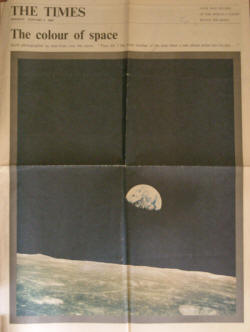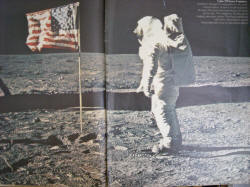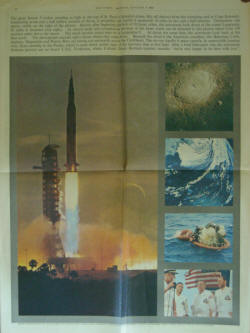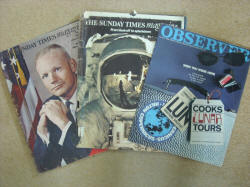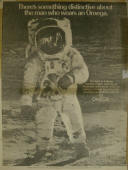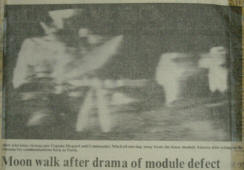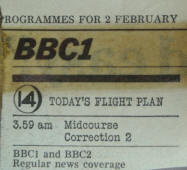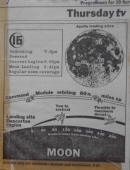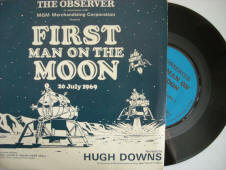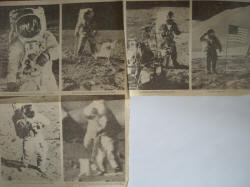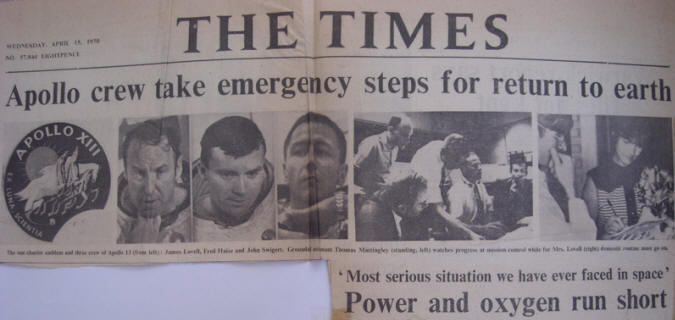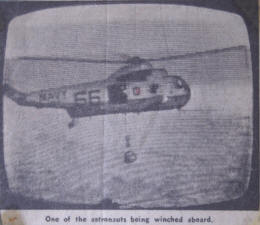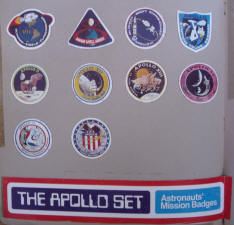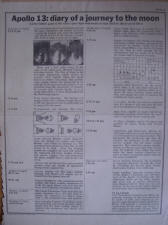| xxxxxxxxxxxxxxxxxxii |
- Apollo 11, headline in The Glasgow Herald, July
1969
- Daily Mirror "book of space" first published in
1970. Intended for children, but contains a full
technical specification of the stages of the Saturn V rocket
- Apollo 8, The Times colour supplement (very
unusual for that time), January 1969. I took this in to
my class in Primary 2, and it was on the wall till Easter.
I fished it out of the bin as bafflingly (to me) the teacher did not
give it back to me.
- Apollo 11, Sunday Times magazine, July 1969.
This is one of the famous photos of Buzz Aldrin saluting the
American flag. There is widely available
time elapsed
film from the colour still camera in the Lunar Module that shows
how the flag was erected including the infamous wire along the top.
It even shows the moment this photo was taken.
- Apollo 11, Sunday Times and Observer magazines,
July 1969. Only once the astronauts had returned to
earth could the memorable photos be published
- Apollo 11, contemporary newspaper advert, 1969.
To this day Omega advertise that only their watches were worn on the
moon. However Buzz Aldrin did not wear it on the outside
of his spacesuit.
- Apollo 14, The Times, February 1971.
This was the mission where the on board computer on the Lunar Module
was re-programmed during the descent to the surface to prevent an
abort alarm. Alan Shepard became the oldest person to
walk on the moon and celebrated by playing some golf.
- Apollo 14, Radio Times, February 1971.
The Radio Times was brimming full of information about every mission
event regardless of whether there was a broadcast associated with it
or not.
- Apollo 16, Radio Times, April 1972.
It is not clear how many of the public would have known the
difference between "miles" and "nautical miles" or understood what
"yaw" meant. Note also that 7.08pm was represented as
7.8pm in those days.
- Apollo 11, Observer single, July 1969.
The only non-written way of re-living the moon landing.
No cassettes, no video, no DVD, no Internet in 1969.
- Apollo 13, headline in The Times, April 1970
- Apollo 13, The Times, April 1970. The
headline is part of a two page article explaining how the Apollo 13
rescue would work.
- Apollo 15, The Times, August 1970.
Yet another iconic photograph from the moon - this time it's of
James Irwin saluting (again) the flag. See the colour
version
here. This mission was probably the most spectacular
as the landing site was in Hadley Rille. It had
mountains, craters, rocks and all with a colour TV camera for the
first time. See this photo being set up from the
perspective of the lunar rover
here.
- Apollo summary, The Times, December 1972.
This is a summary of all the missions to land on the moon.
Even before the final Apollo was complete, people were asking if it
had all been worth it.
- Apollo 17, Radio Times, December 1972.
The final mission - blasting off on prime time TV in the US, but the
middle of the night in the UK.
- Apollo 9, The Glasgow Herald, March 1969.
All Apollo missions splashed down in the Pacific Ocean.
The crew were picked up by Navy helicopters and returned to a nearby
aircraft carrier.
- Apollo badges. Every Apollo mission
had an associated badge which the crew wore on the space suits.
The Apollo 17 badge is missing here as it had yet to fly.
Much of the moon memorabilia and books were published before Apollo
17 to capitalise on the interest before the final mission had flown.
- Apollo 13, Radio Times, April 1970.
This is the original mission plan, showing how and when Apollo 13
would land on the moon. The explosion that caused the
mission to be aborted occurred two days after blast off so the plan
completely changed after the entry for Monday 13 April.
- Apollo 15, Radio Times, July 1970.
James Burke and Patrick Moore were the stalwarts of the BBC moon
specials. Burke, a true enthusiast, and Moore, a true
astronomer brought the whole show to life. They are seen
here sitting in the lunar rover (or lunar buggy) which Apollo 15
took to the moon for the first time.
|
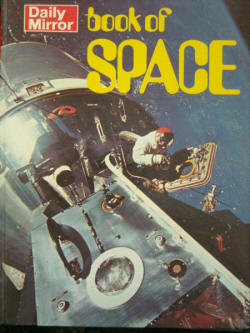 ii
ii 
